
A | B | C | D | E | F | G | H | CH | I | J | K | L | M | N | O | P | Q | R | S | T | U | V | W | X | Y | Z | 0 | 1 | 2 | 3 | 4 | 5 | 6 | 7 | 8 | 9
United States Congress | |
|---|---|
| 118th United States Congress | |
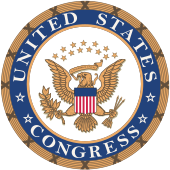 | |
| Type | |
| Type | |
| Houses | Senate House of Representatives |
| History | |
| Founded | March 4, 1789 |
| Preceded by | Congress of the Confederation |
New session started | January 3, 2023 |
| Leadership | |
| Structure | |
| Seats |
|
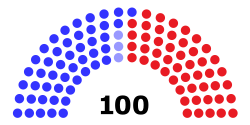 | |
Senate political groups | Majority (51)
Minority (49)
|
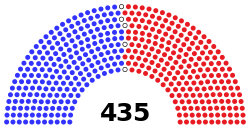 | |
House of Representatives political groups | Majority (217)
Minority (213)
|
| Elections | |
Last Senate election | November 8, 2022 |
Last House of Representatives election | November 8, 2022 |
Next Senate election | November 5, 2024 |
Next House of Representatives election | November 5, 2024 |
| Meeting place | |
 | |
| United States Capitol Washington, D.C. United States of America | |
| Website | |
| www | |
| Constitution | |
| United States Constitution, article I | |
| This article is part of a series on the |
| Politics of the United States |
|---|
 |
The United States Congress is the legislature of the federal government of the United States. It is bicameral, composed of a lower body, the House of Representatives, and an upper body, the Senate. It meets in the U.S. Capitol in Washington, D.C. Senators and representatives are chosen through direct election, though vacancies in the Senate may be filled by a governor's appointment. Congress[b] has 535 voting members: 100 senators and 435 representatives. The U.S. vice president has a vote in the Senate only when senators are evenly divided. The House of Representatives has six non-voting members.[4]
The sitting of a Congress is for a two-year term, at present, beginning every other January. Elections are held every even-numbered year on Election Day. The members of the House of Representatives are elected for the two-year term of a Congress. The Reapportionment Act of 1929 established that there be 435 representatives, and the Uniform Congressional Redistricting Act requires that they be elected from single-member constituencies or districts. It is also required that the congressional districts be apportioned among states by population every ten years using the U.S. census results, provided that each state has at least one congressional representative. Each senator is elected at-large in their state for a six-year term, with terms staggered, so every two years approximately one-third of the Senate is up for election. Each state, regardless of population or size, has two senators, so currently, there are 100 senators for the 50 states.
Article One of the U.S. Constitution requires that members of Congress must be at least 25 years old (House) or at least 30 years old (Senate), have been a citizen of the U.S. for seven (House) or nine (Senate) years, and be an inhabitant of the state which they represent. Members in both chambers may stand for re-election an unlimited number of times.
The Congress was created by the U.S. Constitution and first met in 1789, replacing the Congress of the Confederation in its legislative function. Although not legally mandated, in practice since the 19th century, Congress members are typically affiliated with one of the two major parties, the Democratic Party or the Republican Party, and only rarely with a third party or independents affiliated with no party. In the case of the latter, the lack of affiliation with a political party does not mean that such members are unable to caucus with members of the political parties. Members can also switch parties at any time, although this is quite uncommon.
Overview
Article One of the United States Constitution states, "All legislative Powers herein granted shall be vested in a Congress of the United States, which shall consist of a Senate and House of Representatives." The House and Senate are equal partners in the legislative process – legislation cannot be enacted without the consent of both chambers. The Constitution grants each chamber some unique powers. The Senate ratifies treaties and approves presidential appointments while the House initiates revenue-raising bills.

The House initiates impeachment cases, while the Senate decides impeachment cases.[5] A two-thirds vote of the Senate is required before an impeached person can be removed from office.[5]
The term Congress can also refer to a particular meeting of the legislature. A Congress covers two years; the current one, the 118th Congress, began on January 3, 2023, and will end on January 3, 2025. Since the adoption of the Twentieth Amendment to the United States Constitution, the Congress has started and ended at noon on the third day of January of every odd-numbered year. Members of the Senate are referred to as senators; members of the House of Representatives are referred to as representatives, congressmen, or congresswomen.
Scholar and representative Lee H. Hamilton asserted that the "historic mission of Congress has been to maintain freedom" and insisted it was a "driving force in American government"[6] and a "remarkably resilient institution".[7] Congress is the "heart and soul of our democracy", according to this view, even though legislators rarely achieve the prestige or name recognition of presidents or Supreme Court justices; one wrote that "legislators remain ghosts in America's historical imagination." One analyst argues that it is not a solely reactive institution but has played an active role in shaping government policy and is extraordinarily sensitive to public pressure.[8] Several academics described Congress:
Congress reflects us in all our strengths and all our weaknesses. It reflects our regional idiosyncrasies, our ethnic, religious, and racial diversity, our multitude of professions, and our shadings of opinion on everything from the value of war to the war over values. Congress is the government's most representative body ... Congress is essentially charged with reconciling our many points of view on the great public policy issues of the day.
— Smith, Roberts, and Wielen[6]
Congress is constantly changing and is constantly in flux.[9] In recent times, the American South and West have gained House seats according to demographic changes recorded by the census and includes more women and minorities.[9] While power balances among the different parts of government continue to change, the internal structure of Congress is important to understand along with its interactions with so-called intermediary institutions such as political parties, civic associations, interest groups, and the mass media.[8]
The Congress of the United States serves two distinct purposes that overlap: local representation to the federal government of a congressional district by representatives and a state's at-large representation to the federal government by senators.
Most incumbents seek re-election, and their historical likelihood of winning subsequent elections exceeds 90 percent.[10]
The historical records of the House of Representatives and the Senate are maintained by the Center for Legislative Archives, which is a part of the National Archives and Records Administration.[11]
Congress is directly responsible for the governing of the District of Columbia, the current seat of the federal government.
History
The First Continental Congress was a gathering of representatives from twelve of the thirteen colonies of North America.[12] On July 4, 1776, the Second Continental Congress adopted the Declaration of Independence, referring to the new nation as the "United States of America". The Articles of Confederation in 1781 created the Congress of the Confederation, a unicameral body with equal representation among the states in which each state had a veto over most decisions. Congress had executive but not legislative authority, and the federal judiciary was confined to admiralty[13] and lacked authority to collect taxes, regulate commerce, or enforce laws.[14][15]
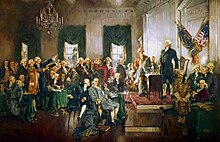
Government powerlessness led to the Convention of 1787 which proposed a revised constitution with a two-chamber or bicameral Congress.[16] Smaller states argued for equal representation for each state.[17] The two-chamber structure had functioned well in state governments.[18] A compromise plan, the Connecticut Compromise, was adopted with representatives chosen by population (benefiting larger states) and exactly two senators chosen by state governments (benefiting smaller states).[9][19] The ratified constitution created a federal structure with two overlapping power centers so that each citizen as an individual is subject to the powers of state government and national government.[20][21][22] To protect against abuse of power, each branch of government – executive, legislative, and judicial – had a separate sphere of authority and could check other branches according to the principle of the separation of powers.[5] Furthermore, there were checks and balances within the legislature since there were two separate chambers.[23] The new government became active in 1789.[5][24]
Political scientist Julian E. Zelizer suggested there were four main congressional eras, with considerable overlap, and included the formative era (1780s–1820s), the partisan era (1830s–1900s), the committee era (1910s–1960s), and the contemporary era (1970–present).[25]
1780s–1820s: Formative era
Federalists and anti-federalists jostled for power in the early years as political parties became pronounced. With the passage of the Constitution and the Bill of Rights, the anti-federalist movement was exhausted. Some activists joined the Anti-Administration Party that James Madison and Thomas Jefferson were forming about 1790–1791 to oppose policies of Treasury Secretary Alexander Hamilton; it soon became the Democratic-Republican Party or the Jeffersonian Republican Party[26] and began the era of the First Party System. Thomas Jefferson's election to the presidency marked a peaceful transition of power between the parties in 1800. John Marshall, 4th chief justice of the Supreme Court, empowered the courts by establishing the principle of judicial review in law in the landmark case Marbury v. Madison in 1803, effectively giving the Supreme Court a power to nullify congressional legislation.[27][28]
1830s–1900s: Partisan era
These years were marked by growth in the power of political parties. The watershed event was the Civil War which resolved the slavery issue and unified the nation under federal authority but weakened the power of states' rights. The Gilded Age (1877–1901) was marked by Republican dominance of Congress. During this time, lobbying activity became more intense, particularly during the administration of President Ulysses S. Grant in which influential lobbies advocated for railroad subsidies and tariffs on wool.[29] Immigration and high birth rates swelled the ranks of citizens and the nation grew at a rapid pace. The Progressive Era was characterized by strong party leadership in both houses of Congress as well as calls for reform; sometimes reformers said lobbyists corrupted politics.[30] The position of Speaker of the House became extremely powerful under leaders such as Thomas Reed in 1890 and Joseph Gurney Cannon. By the beginning of the 20th century, party structures and leadership emerged as key organizers of Senate proceedings.[31]
1910s–1960s: Committee era

A system of seniority, in which long-time members of Congress gained more and more power, encouraged politicians of both parties to seek long terms. Committee chairmen remained influential in both houses until the reforms of the 1970s.[citation needed]
Important structural changes included the direct popular election of senators according to the Seventeenth Amendment,[19] ratified on April 8, 1913. Supreme Court decisions based on the Constitution's commerce clause expanded congressional power to regulate the economy.[32] One effect of popular election of senators was to reduce the difference between the House and Senate in terms of their link to the electorate.[33] Lame duck reforms according to the Twentieth Amendment reduced the power of defeated and retiring members of Congress to wield influence despite their lack of accountability.[34]
The Great Depression ushered in President Franklin Roosevelt and strong control by Democrats[35] and historic New Deal policies. Roosevelt's election in 1932 marked a shift in government power towards the executive branch. Numerous New Deal initiatives came from the White House rather initiated by Congress.[36] President Roosevelt pushed his agenda in Congress by detailing Executive Branch staff to friendly Senate committees (a practice that ended with the Legislative Reorganization Act of 1946).[37] The Democratic Party controlled both houses of Congress for many years.[38][39][40] During this time, Republicans and conservative southern Democrats[41] formed the Conservative Coalition.[40][42] Democrats maintained control of Congress during World War II.[43][44] Congress struggled with efficiency in the postwar era partly by reducing the number of standing congressional committees.[45] Southern Democrats became a powerful force in many influential committees although political power alternated between Republicans and Democrats during these years. More complex issues required greater specialization and expertise, such as space flight and atomic energy policy.[45] Senator Joseph McCarthy exploited the fear of communism during the Second Red Scare and conducted televised hearings.[46][47] In 1960, Democratic candidate John F. Kennedy narrowly won the presidency and power shifted again to the Democrats who dominated both houses of Congress until 1994.[citation needed]
Since 1970: contemporary era

Congress enacted Johnson's Great Society program to fight poverty and hunger. The Watergate Scandal had a powerful effect of waking up a somewhat dormant Congress which investigated presidential wrongdoing and coverups; the scandal "substantially reshaped" relations between the branches of government, suggested political scientist Bruce J. Schulman.[49] Partisanship returned, particularly after 1994; one analyst attributes partisan infighting to slim congressional majorities which discouraged friendly social gatherings in meeting rooms such as the Board of Education.[8] Congress began reasserting its authority.[36][50] Lobbying became a big factor despite the 1971 Federal Election Campaign Act. Political action committees or PACs could make substantive donations to congressional candidates via such means as soft money contributions.[51] While soft money funds were not given to specific campaigns for candidates, the money often benefited candidates substantially in an indirect way and helped reelect candidates.[51] Reforms such as the 2002 Bipartisan Campaign Reform Act limited campaign donations but did not limit soft money contributions.[52] One source suggests post-Watergate laws amended in 1974 meant to reduce the "influence of wealthy contributors and end payoffs" instead "legitimized PACs" since they "enabled individuals to band together in support of candidates".[53] From 1974 to 1984, PACs grew from 608 to 3,803 and donations leaped from $12.5 million to $120 million[53][54][55] along with concern over PAC influence in Congress.[56][57] In 2009, there were 4,600 business, labor and special-interest PACs[58] including ones for lawyers, electricians, and real estate brokers.[59] From 2007 to 2008, 175 members of Congress received "half or more of their campaign cash" from PACs.[58][60][61]
From 1970 to 2009, the House expanded delegates, along with their powers and privileges representing U.S. citizens in non-state areas, beginning with representation on committees for Puerto Rico's resident commissioner in 1970. In 1971, a delegate for the District of Columbia was authorized, and in 1972 new delegate positions were established for U.S. Virgin Islands and Guam. 1978 saw an additional delegate for American Samoa, and another for the Commonwealth of the Northern Mariana Islands began in 2009. These six members of Congress enjoy floor privileges to introduce bills and resolutions, and in recent Congresses they vote in permanent and select committees, in party caucuses and in joint conferences with the Senate. They have Capitol Hill offices, staff and two annual appointments to each of the four military academies. While their votes are constitutional when Congress authorizes their House Committee of the Whole votes, recent Congresses have not allowed for that, and they cannot vote when the House is meeting as the House of Representatives.[62]

In the late 20th century, the media became more important in Congress's work.[63] Analyst Michael Schudson suggested that greater publicity undermined the power of political parties and caused "more roads to open up in Congress for individual representatives to influence decisions".[63] Norman Ornstein suggested that media prominence led to a greater emphasis on the negative and sensational side of Congress, and referred to this as the tabloidization of media coverage.[9] Others saw pressure to squeeze a political position into a thirty-second soundbite.[64] A report characterized Congress in 2013 as unproductive, gridlocked, and "setting records for futility".[65] In October 2013, with Congress unable to compromise, the government was shut down for several weeks and risked a serious default on debt payments, causing 60% of the public to say they would "fire every member of Congress" including their own representative.[66] One report suggested Congress posed the "biggest risk to the U.S. economy" because of its brinksmanship, "down-to-the-wire budget and debt crises" and "indiscriminate spending cuts", resulting in slowed economic activity and keeping up to two million people unemployed.[67] There has been increasing public dissatisfaction with Congress,[68] with extremely low approval ratings[69][70] which dropped to 5% in October 2013.[71]
On January 6, 2021, the Congress gathered to confirm the election of Joe Biden, when supporters of the outgoing president Donald Trump attacked the building. The session of Congress ended prematurely, and Congress representatives evacuated. Trump supporters occupied Congress until D.C police evacuated the area. The event was the first time since the Burning of Washington that the United States Congress was forcefully occupied.[72]
Women in Congress
Various social and structural barriers have prevented women from gaining seats in Congress. In the early 20th century, women's domestic roles and the inability to vote forestalled opportunities to run for and hold public office. The two party system and the lack of term limits favored incumbent white men, making the widow's succession – in which a woman temporarily took over a seat vacated by the death of her husband – the most common path to Congress for white women.[73]
Women candidates began making substantial inroads in the later 20th century, due in part to new political support mechanisms and public awareness of their underrepresentation in Congress. [74] Recruitment and financial support for women candidates were rare until the second-wave feminism movement, when activists moved into electoral politics. Beginning in the 1970s, donors and political-action-committees like EMILY's List began recruiting, training and funding women candidates. Watershed political moments like the confirmation of Clarence Thomas and the 2016 presidential election created momentum for women candidates, resulting in the Year of the Woman and the election of members of The Squad, respectively.[citation needed]
Women of color faced additional challenges that made their ascension to Congress even more difficult. Jim Crow laws, voter suppression and other forms of structural racism made it virtually impossible for women of color to reach Congress prior to 1965. The passage of the Voting Rights Act that year, and the elimination of race-based immigration laws in the 1960s opened the possibility for Black, Asian American, Latina and other non-white women candidates to run for Congress.[75]
Racially polarized voting, racial stereotypes and lack of institutional support still prevent women of color from reaching Congress as easily as white people. Senate elections, which require victories in statewide electorates, have been particularly difficult for women of color.[76] Carol Moseley Braun became the first woman of color to reach the Senate in 1993. The second, Mazie Hirono, won in 2013.
In 2021, Kamala Harris became the first female President of the Senate, which came with her role as the first female Vice President of the United States.
Role
Powers
Overview
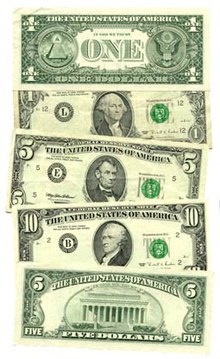
Article One of the Constitution creates and sets forth the structure and most of the powers of Congress. Sections One through Six describe how Congress is elected and gives each House the power to create its own structure. Section Seven lays out the process for creating laws, and Section Eight enumerates numerous powers. Section Nine is a list of powers Congress does not have, and Section Ten enumerates powers of the state, some of which may only be granted by Congress.[77] Constitutional amendments have granted Congress additional powers. Congress also has implied powers derived from the Constitution's Necessary and Proper Clause.
Congress has authority over financial and budgetary policy through the enumerated power to "lay and collect Taxes, Duties, Imposts and Excises, to pay the Debts and provide for the common Defence and general Welfare of the United States". There is vast authority over budgets, although analyst Eric Patashnik suggested that much of Congress's power to manage the budget has been lost when the welfare state expanded since "entitlements were institutionally detached from Congress's ordinary legislative routine and rhythm."[78] Another factor leading to less control over the budget was a Keynesian belief that balanced budgets were unnecessary.[78]
The Sixteenth Amendment in 1913 extended congressional power of taxation to include income taxes without apportionment among the several States, and without regard to any census or enumeration.[79] The Constitution also grants Congress the exclusive power to appropriate funds, and this power of the purse is one of Congress's primary checks on the executive branch.[79] Congress can borrow money on the credit of the United States, regulate commerce with foreign nations and among the states, and coin money.[80] Generally, the Senate and the House of Representatives have equal legislative authority, although only the House may originate revenue and appropriation bills.[5]

Congress has an important role in national defense, including the exclusive power to declare war, to raise and maintain the armed forces, and to make rules for the military.[81] Some critics charge that the executive branch has usurped Congress's constitutionally defined task of declaring war.[82] While historically presidents initiated the process for going to war, they asked for and received formal war declarations from Congress for the War of 1812, the Mexican–American War, the Spanish–American War, World War I, and World War II,[83] although President Theodore Roosevelt's military move into Panama in 1903 did not get congressional approval.[83] In the early days after the North Korean invasion of 1950, President Truman described the American response as a "police action".[84] According to Time magazine in 1970, "U.S. presidents ordered troops into position or action without a formal congressional declaration a total of 149 times."[83] In 1993, Michael Kinsley wrote that "Congress's war power has become the most flagrantly disregarded provision in the Constitution," and that the "real erosion began after World War II."[85][86][87] Disagreement about the extent of congressional versus presidential power regarding war has been present periodically throughout the nation's history.[88]
Congress can establish post offices and post roads, issue patents and copyrights, fix standards of weights and measures, establish Courts inferior to the Supreme Court, and "make all Laws which shall be necessary and proper for carrying into Execution the foregoing Powers, and all other Powers vested by this Constitution in the Government of the United States, or in any Department or Officer thereof". Article Four gives Congress the power to admit new states into the Union.
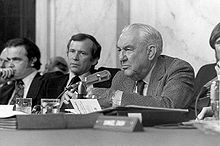
One of Congress's foremost non-legislative functions is the power to investigate and oversee the executive branch.[89] Congressional oversight is usually delegated to committees and is facilitated by Congress's subpoena power.[90] Some critics have charged that Congress has in some instances failed to do an adequate job of overseeing the other branches of government. In the Plame affair, critics including Representative Henry A. Waxman charged that Congress was not doing an adequate job of oversight in this case.[91] There have been concerns about congressional oversight of executive actions such as warrantless wiretapping, although others respond that Congress did investigate the legality of presidential decisions.[92] Political scientists Ornstein and Mann suggested that oversight functions do not help members of Congress win reelection. Congress also has the exclusive power of removal, allowing impeachment and removal of the president, federal judges and other federal officers.[93] There have been charges that presidents acting under the doctrine of the unitary executive have assumed important legislative and budgetary powers that should belong to Congress.[94] So-called signing statements are one way in which a president can "tip the balance of power between Congress and the White House a little more in favor of the executive branch", according to one account.[95] Past presidents, including Ronald Reagan, George H. W. Bush, Bill Clinton, and George W. Bush,[96] have made public statements when signing congressional legislation about how they understand a bill or plan to execute it, and commentators, including the American Bar Association, have described this practice as against the spirit of the Constitution.[97][98] There have been concerns that presidential authority to cope with financial crises is eclipsing the power of Congress.[99] In 2008, George F. Will called the Capitol building a "tomb for the antiquated idea that the legislative branch matters".[100]
Enumeration
Zdroj:https://en.wikipedia.org?pojem=United_States_CongressText je dostupný za podmienok Creative Commons Attribution/Share-Alike License 3.0 Unported; prípadne za ďalších podmienok. Podrobnejšie informácie nájdete na stránke Podmienky použitia.
Antropológia
Aplikované vedy
Bibliometria
Dejiny vedy
Encyklopédie
Filozofia vedy
Forenzné vedy
Humanitné vedy
Knižničná veda
Kryogenika
Kryptológia
Kulturológia
Literárna veda
Medzidisciplinárne oblasti
Metódy kvantitatívnej analýzy
Metavedy
Metodika
Text je dostupný za podmienok Creative
Commons Attribution/Share-Alike License 3.0 Unported; prípadne za ďalších
podmienok.
Podrobnejšie informácie nájdete na stránke Podmienky
použitia.
www.astronomia.sk | www.biologia.sk | www.botanika.sk | www.dejiny.sk | www.economy.sk | www.elektrotechnika.sk | www.estetika.sk | www.farmakologia.sk | www.filozofia.sk | Fyzika | www.futurologia.sk | www.genetika.sk | www.chemia.sk | www.lingvistika.sk | www.politologia.sk | www.psychologia.sk | www.sexuologia.sk | www.sociologia.sk | www.veda.sk I www.zoologia.sk

